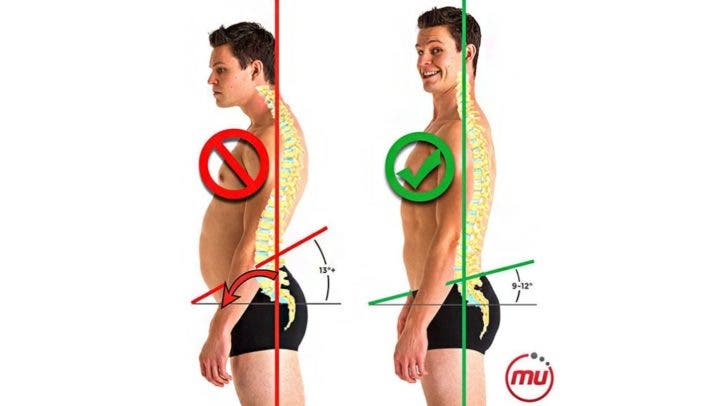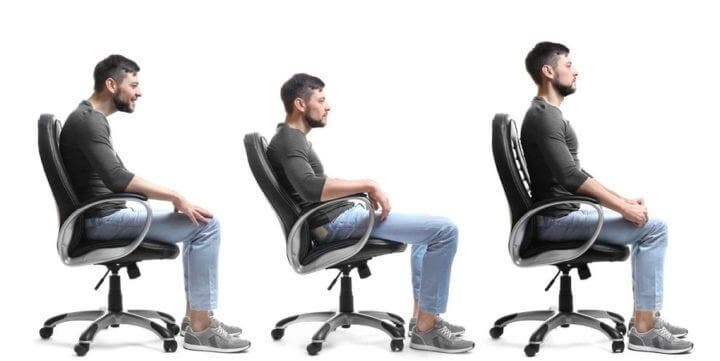In the era where the use of cell phones, video games and computers is predominant, it is not difficult to imagine that most adolescents end up with poor posture. Unfortunately, adults are not excluded from this phenomenon due to their constant exposure to hours of work in front of a desk.
Long-term poor posture has health consequences , from chronic neck, back, and foot pain to breathing and stomach problems. Today, the effects of a mediocre posture are still investigated for its frequent development. Because of this, we explain how body posture affects your body and some tips to reverse its effects.

Areas affected by body posture
1. Head and neck
The areas most affected by poor body posture are probably the muscles behind the head, which put pressure on nearby nerves creating headaches.
In this regard, relationships have been found between neck problems and poor posture due to constantly looking down (towards a mobile phone or tablet), since, by tilting your head forward, your head doubles its weight and it is positioned in the tip of the spine.
2. The jaw
As you might suspect, a forward lean posture puts too much pressure on the muscles around the temporomandibular joint, ultimately leading to pain and various problems opening the jaw. A study conducted in this regard found that correcting posture helps with pain from this condition (Jaeger, Oakley, Moore, Ruggeroli & Harrison, 2018).

3. Your shoulders
The problem with poor posture is that it damages the rotator cuff tendons; that is, those muscles and tendons that are found in the upper arm and connect it with the shoulder. This condition is known as shoulder impingement and if not treated seriously it can cause a painful tear and weakness. on the affected shoulder.
In fact, experts have found that people with shoulder impingements are much more likely to have poor posture compared to people without this condition (Alizadehkhaiyat, Roebuck, Makki & Frostick, 2017).
4. Your back
Naturally, the average person's back should have 3 curves : one inward at the neck, one outward at the upper back, and one inward at the bottom. In this way, if you maintain a straight posture, you are helping that form to be maintained; Whereas if you slouch, you stress the muscles around it.
Usually, people who do this have a weak core, which makes it even worse because instead of easing the situation, they put all the pressure on the spine . In relation to this, a study carried out in more than 500 people with chronic back or shoulder pain found that, when they improved their posture, their symptoms also decreased (Cramer, Mehling, Saha, Dobos and Lauche, 2018).

5. Your breathing
No one imagines that poor posture can affect breathing, but this is the case when it puts too much pressure on the chest area and does not allow the diaphragm to open fully .
The research that supports this information affirms that poor posture, especially one that leans forward, limits breathing, affecting lung capacity (Han, Park, Kim, Choi & Lyu, 2016). The end result is a feeling of heaviness and fatigue in the individual.
How to fix bad body posture
- Sitting correctly : keep your feet on the ground with your knees below hip level and your forearms parallel to the ground. Make sure you have a chair that supports your back and lower back.
- Don't hold too much weight for your body, as you will be putting pressure on your lower back. Better opt for options that you can carry by your side such as wheeled backpacks or trolleys.
- Try a yoga or tai chi class to open up your chest and upper back, and counteract the negative effects of poor posture .
- Sleep in a strategic neutral position: try to find a way for your back to always stay straight and don't sleep on your stomach because it misaligns your body.
On the other hand, the following exercises can help you correct postural problems :

Scapular wall slides
- Stand with your feet hip-width apart in a squat position, with your back and head pressed against the wall.
- Position your arms as close to the wall as you can at a 90 ° angle.
- Slide your arms toward the wall and return to the center, then slide them down.
Don't forget to tuck your chin in and repeat the exercise 10 times.

External shoulder rotations
- Stand with your feet hip-width apart, with your elbows against the sides of your body and your arms at a 90 ° angle.
- Slowly rotate both shoulders, keeping the elbows at the sides of the body and trying to touch the shoulder blades.
- Return to the starting position and repeat the exercise 10 times.

conclusion
Posture problems can develop scoliosis or similar disorders that, if not treated at the right time, can leave sequelae for the rest of your life. Therefore, to alleviate the symptoms of poor posture, you should research exercises that are appropriate to your needs.
References
- Alizadehkhaiyat, O., Roebuck, MM, Makki, AT and Frostick, SP (2017). Postural Alterations in patients with subacromial impingement syndrome. International Journal of Sports Physical Therapy. doi: 10.26603 / ijspt20171111
- Cramer, H., Mehling, WE, Saha, FJ, Dobos, G. and Lauche, R. (2018). Postural awareness and its relation to pain: validation of an innovative instrument measuring awareness of body posture in patients with chronic pain. BMC Musculoskeletal Disorders. doi: 10.1186 / s12891-018-2031-9
- Han, J., Park, S., Kim, Y., Choi, Y. and Lyu, H. (2016). Effects of forward head posture on forced vital capacity and respiratory muscles activity. Journal of Physical Therapy Science. doi: 10.1589 / jpts.28.128
- Jaeger, JO, Oakley, PA, Moore, RR, Ruggeroli, EP and Harrison, DE (2018). Resolution of temporomandibular joint dysfunction (TMJD) by correcting a lateral head translation posture following previous failed traditional chiropractic therapy: a CBP® case report. Journal of Physical Therapy Science. doi: 10.1589 / jpts.30.103
